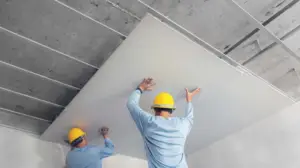Gain insights from this article as we talk about Oldest Buildings in the World.
The shaping and molding of our present-day world have been significantly influenced by historical construction endeavors.
Whether it’s the iconic pyramids, the enchanting hanging gardens, Buckingham Palace, or the ancient city of Athens, these ancient structures have left an indelible mark on contemporary construction practices and perspectives.
Delving deeper into the world’s most ancient buildings offers us a glimpse into the values cherished by our ancestors, how they preserved their cultures and provides insights into life thousands of years ago.
Let’s embark on a journey to explore these venerable architectural marvels.
How were they brought into existence? What purposes did they serve?
What intricate construction techniques were employed in their creation?
Most importantly, do these age-old edifices still stand today?
In this comprehensive guide, we’ll unveil the intriguing stories behind the five oldest buildings in the world.

PHOTO Courtesy | WorldAtlas
1. Cairn of Barnenez
Located in Northern France, the Cairn of Barnenez stands as an ancient monument with a remarkable history.
Dating back to 4800 BCE, it ranks as the second oldest structure globally and holds the distinction of being the most extensive megalithic mausoleum ever unearthed.

PHOTO Courtesy | wikimedia
These megalithic mausoleums, housing tombs and burial chambers are typically constructed underground and were viewed as conduits for the departed to journey into the afterlife.
In the 1850s, this structure was initially identified as a tumulus, an artificial mound fashioned by human hands.
However, approximately a century later, quarry operations penetrated this mound, revealing not merely a tumulus but a carefully crafted stone building beneath the surface.
This discovery prompted an immediate halt to quarrying activities and initiated a concerted effort to restore and excavate this historically significant structure.
Within the Cairn of Barnenez, there are 11 passage tombs thoughtfully integrated into the interior.
The profound significance of burial rituals and practices throughout history is evident, mirroring their importance in contemporary times.
These 11 passage tombs were constructed in two phases, reflecting the growing need for additional space to accommodate the departed.
Construction of the Cairn of Barnenez
The construction of the Cairn of Barnenez unfolded in two distinct phases.
The initial phase commenced around 4850 BCE, while the second phase commenced approximately 650 years later, around 4200 BCE.
These two construction stages are discernible through noticeable variations in the physical structure of certain tombs.
In the first phase, the stone houses were fashioned from dolerite, a fine-grained rock, while the second phase employed granite, a coarser-grained material, to cool and reinforce the subterranean passageways.
Furthermore, disparities extend to the number of tombs present.
The first construction phase comprised six passage chambers, whereas the second phase incorporated only five, resulting in a combined total of eleven tombs.
Detailed information about the equipment and workforce employed during this construction era is scarce.
However, it is reasonable to assume that given the antiquity of the structure, labor was labor-intensive, and the available equipment was limited.
The Cairn of Barnenez Today
The Cairn of Barnenez endures to this day, solidifying its status as one of the world’s most ancient freestanding stone mausoleums.
While guided tours of this remarkable historical structure are offered, it’s worth noting that some interior sections remain inaccessible to tourists due to safety precautions stemming from its prior use as a quarry.
2. Uruk
Uruk stands as another of the planet’s ancient structures, although it’s not just a single edifice but rather an ancient city.
In fact, it is believed to be the very first city ever established, comprising numerous temples and other structures in what is now Iraq.
Uruk represents a pivotal moment in the evolution of human civilization.
Erected in 4000 BCE, Uruk served as the home for approximately 40,000 residents.

PHOTO Courtesy | Mostly History
Archaeological investigations have revealed the presence of 20 temples, 1 room, 2 standard halls, 1 grand hall, and 4 structures dedicated to bathing and essential needs among the remaining ruins.
The diverse range of buildings within the city of Uruk ensured a comfortable living environment for its 40,000 inhabitants, with the capacity to accommodate up to 80,000 people during different periods.
The Ancient City
Uruk’s fundamental purpose closely mirrors that of modern cities, encompassing aspects of residence, social interactions, governance, and employment.
Temples served as communal housing for the city’s inhabitants, while halls were designated for dining and civic gatherings.
Additionally, various other structures were allocated for activities such as bathing, religious practices, and agricultural labor.
It’s worth noting the immense scale of this city, spanning a vast expanse of 2.1 square miles.
Construction of Uruk
The construction of the city of Uruk was a formidable and protracted undertaking that spanned numerous years.
Given that it involved the creation of not just one building but many, meticulous planning was imperative.
Architects had the arduous task of devising a layout that determined the placement of temples, structures, and halls, envisioning how the entire city would function cohesively and facilitate movement.
The primary construction material employed in this ambitious project was adobe brick, a composite composed of soil, organic elements like straw and dung, as well as stones compacted into brick-like forms and subsequently dried.
These bricks, commonly referred to as mudbricks, played a pivotal role in shaping Uruk’s architectural landscape.
Adobe Brick in Construction
The adobe brick played a crucial part in ensuring the city’s durability by controlling temperature and solidifying effectively, thus ensuring its stability over time.
The construction of Uruk was a collective effort involving every resident, with an emphasis on demanding physical labor.
While it remains uncertain whether participation in construction was obligatory for city dwellers, it is reasonable to presume that construction activities within the city were an ongoing engagement for its residents.
Uruk Today
Uruk remains standing to this day, welcoming tourists to journey to Iraq and discover its historical treasures.
For those with a keen interest in unraveling the history of human civilization, a visit to Uruk is an absolute imperative.
3. Göbekli Tepe
Göbekli Tepe, situated in Southeastern Turkey, is an archaeological site hosting a temple dating back to 9500 – 8000 BCE.
The establishment of this timeline was determined through carbon dating of ancient tools unearthed during excavations.
Remarkably, this structure stands as the oldest known edifice on Earth, predating even the Egyptian pyramids and Stonehenge.

PHOTO Courtesy | BBC/ Michele Burgess/Alamy
The composition of Göbekli Tepe comprises sizable circular structures supported by stone pillars.
What adds intrigue to this site is that these pillars are adorned with intricate carvings and depictions of animals, including oxen, lions, scorpions, and vultures.
Some of the pillars remain unadorned, while others showcase these animal carvings, adorning all sides.
These carvings offer valuable insights into the way of life during that era.
Archaeologists have deduced that this locale, long before it transformed into a relatively flat and open area through farming, would have resembled a sort of paradise.
The land would have teemed with grazing animals, birds, butterflies, and abundant life.
What Was Göbekli Tepe Used For?
The primary purpose of Göbekli Tepe has sparked debate over the years.
Recently, archaeologists have reached a consensus that this temple likely served as a training ground for hunter-gatherers to refine their skills and prepare for hunting expeditions.
It also functioned as a place of religious worship and devotion, where these individuals could offer prayers and express gratitude to the gods before embarking on hunts.
The practice of carving and depicting animals on the pillars is believed to have been a way of psyching themselves up for encounters with the creatures they would face during hunting.
The structures comprising Göbekli Tepe are constructed from stone materials, including limestone fragments, stone vessels, and stone tools, contributing to the marvel of this building.
Within Göbekli Tepe, there are two layers, with the lower layer being older and presumed to have been an initial phase or experimental stage.
The upper layer, the second phase, might have involved a reimagining of the temple’s construction.
The reasons behind the construction, burial, and subsequent reconstruction of this temple remain shrouded in mystery, adding an intriguing dimension to the structure.
As for the manpower required for its construction, no definitive answer exists.
Given the absence of advanced equipment during that era, it is reasonable to assume that a substantial workforce and considerable labor were necessary to transport and position the stone, sourcing it from quarries and conveying it to the site.
Is the Göbekli Tepe Still Around Today?
The Turkish Ministry of Tourism has initiated an effort to safeguard this structure, with forthcoming intentions encompassing the establishment of a museum to conserve the site in its original state, as initially uncovered by archaeologists Klaus Schmidt, Necmi Karul, and Lee Clare.
4. Tumulus of Bougon
The Tumulus of Bougon, situated in France, ranks as the world’s oldest structure.
Interestingly, this edifice comprises a cluster of five distinct tumuli located within the same vicinity.

PHOTO (dozr)
What Is a Tumulus?
A tumulus refers to heaps of soil or stones placed over graves to elevate them, a practice observed in numerous cultures worldwide.
These burial mounds served two primary purposes.
Firstly, they were a means of honoring the deceased, with the size of the mound often reflecting the importance of the individual interred.
Secondly, practicality played a role, as in many regions, digging through layers of rock, stone, roots, and clay proved challenging, making it easier to build upward and around the burial site.
Similar to the Cairn of Barnenez, the Tumulus of Bougon also served as a burial site.
The Tumulus of Bougon served as a burial ground to commemorate individuals from nearby villages who had passed away.
These burial sites represent some of the world’s oldest examples of funerary architecture.
Each tumulus varies in size and was utilized during different time periods for proper interment.
Through archaeological excavations, various artifacts such as pottery, art, stone tools, and beads have been unearthed at these sites.
Construction of Tumulus of Bougon
The construction of the Tumulus of Bougon unfolded over a span of 1200 years, ranging from 4700 to 3500 BCE.
To create the five components of the Tumulus, the technique of dry stone walling was employed.
Interestingly, a beehive roof structure was also crafted using natural resources like grass and, of course, more stone.
To fortify the structure and avert collapse, drystone walling was incorporated along the periphery of the burial sites.
Similar to the Cairn of Barnenez, there is limited information available regarding the labor force or equipment utilized, suggesting that labor-intensive methods were employed.
Given the era, construction would have relied on manual labor and basic tools.
The extensive duration of construction indicates that the structure was continually expanded and modified as necessary over time.
The Tumulus of Bougon Today
This site remains intact and is indeed a remarkable sight to behold.
The combination of natural surroundings, intricate design, and the thoughtful planning that went into crafting this burial site renders it exceptionally beautiful.
5. Knap of Howar
The Knap of Howar stands as a stone-built farmstead and potentially holds the distinction of being the oldest preserved stone house in all of Europe.
Situated in Scotland, it traces its origins back to 3700 BCE.

PHOTO Courtesy | buildingtalk
This structure comprises two stone-wall buildings perched overlooking the sea.
The first of these stone houses is designated as living quarters, while the second is designated as a workshop.
Both structures relied on fires for warmth and were equipped with roof apertures to allow smoke to escape.
These stone dwellings served agricultural purposes, with evidence suggesting that the inhabitants raised livestock such as cattle, sheep, and pigs.
They also cultivated their own grains.
Given their proximity to the sea, fishing and shellfish gathering likely contributed to their food sources.
Knap of Howar Today
This site in Scotland remains standing to this day, and its full extent has not yet been fully investigated.
Historic Environment Scotland suggests that these two houses are likely components of a broader settlement that has yet to be unearthed.
The Oldest Buildings in the World
These five of the world’s most ancient structures serve as compelling examples of what can be achieved with the right mindset, unwavering determination, and suitable materials.
The enduring presence of these buildings, still standing today, represents a truly remarkable accomplishment and serves as a source of inspiration for contemporary architectural endeavors.



















































